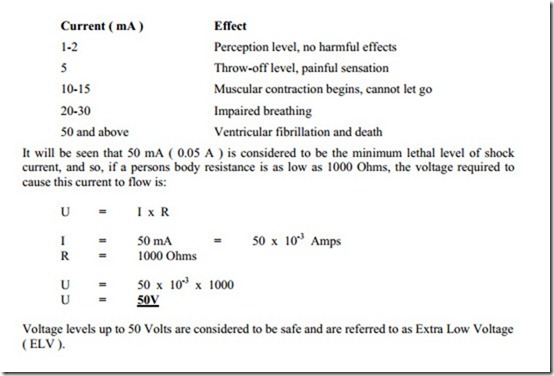Electric Shock
An electric shock is the passage of an electric current through the body. The amount of current which is lethal varies from person to person, and also depends on the parts of the body through which it flows. To understand why we are ‘shocked’, we must realise that every movement we make, conscious or unconscious, is produced by muscles reacting to minute electric currents generated in the brain. These currents are distributed to the correct muscles by the ‘conductors’ of the nervous system.
If a current much larger than the one usually carried is forced through the nervous system, the muscles react much more violently than normal, and hence we experience the ‘kick’ associated with an electric shock. If in addition, the nerves carry the excess current to the brain, it may destroy or cause temporary paralysis of the cells which generate the normal currents. Destruction of these cells means almost instant death, as the heart muscles cease to operate and no blood is circulated. Paralysis results in unconsciousness, but if the lung muscles are not operating, death from suffocation will follow in a few minutes.
Factors Affecting Severity of Electric Shock
The severity of shock depends on the amount of current flowing through the body, the path it takes and the time for which it flows. The amount of current flowing increases as the applied voltage increases, and decreases as circuit resistance increases. Thus, in identical circumstances, a worse shock will be received from a high voltage than from a low voltage.
Many circuits such as those associated with bells and telephones are operated at extra low voltage and so the risk of shock is removed. High voltage shocks are often accompanied by severe burns.
For a given voltage, the severity of the shock received will depend on the circuit resistance. This is made up of the following:
· Resistance of the installation conductors: These form such a small proportion of the total resistance that usually they may be ignored.
· Resistance of the body: This varies considerably from person to person. As the body itself is mainly water, its resistance is quite low. The body, however, is covered by layers of skin which have high resistance. It is in the resistance of the skin that the main variations occur. Some people have a naturally hard skin which has high resistance and others have soft, moist skin of low resistance. If the skin is wet, the moisture penetrates the pores, giving parallel paths of low resistance. A natural result of electric shock is for the victim to perspire profusely. This unfortunately reduces the body resistance and increases the severity of the shock.
Contact with the general mass of earth: The body is normally separated from the conducting mass of earth by one or more layers of insulating material, i.e. shoes, floor coverings, floors, etc. It is the resistance of these insulators which normally prevents a shock from being serious. For instance, a man wearing rubber-soled shoes standing on a thick carpet over a dry wooden floor can touch a live conductor and feel nothing more than a slight tingle. The same man standing on a wet concrete floor in his bare feet would probably not live to describe his sensations on touching it. Depending on whether the body is dry, moist, or wet, the value of resistance measured between hands, or between hands and feet, can be anywhere between 1000W and 10,000W. As we have seen from Ohms law, the current flowing through a body will depend on the voltage across it and the resistance of the body. Different levels of current will have different effects, the worst occurring when the heart goes out of rhythm and will not return to normal. This condition is known as ventricular fibrillation and will often result in death. Below is a guide to the various levels of shock current and their effects on the body.
